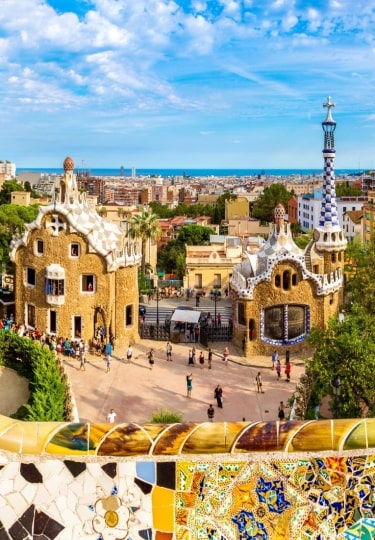Parks in Barcelona run the gamut from leafy squares in the center of the city to vast oases filled with tropical plants.
There’s the elevated Parc de Montjuic that offers dazzling views of the city; the grandiose Parc de la Ciutadella that’s home to a zoo and the Catalan Parliament; and the lesser-known Parc de Cervantes, a small sanctuary near the shopping district.
From the prettiest Barcelona gardens to one of the city’s most famous parks with links to architect Antoni Gaudi, these are parks and gardens to explore in the Catalan capital.
Parc de Montjuïc
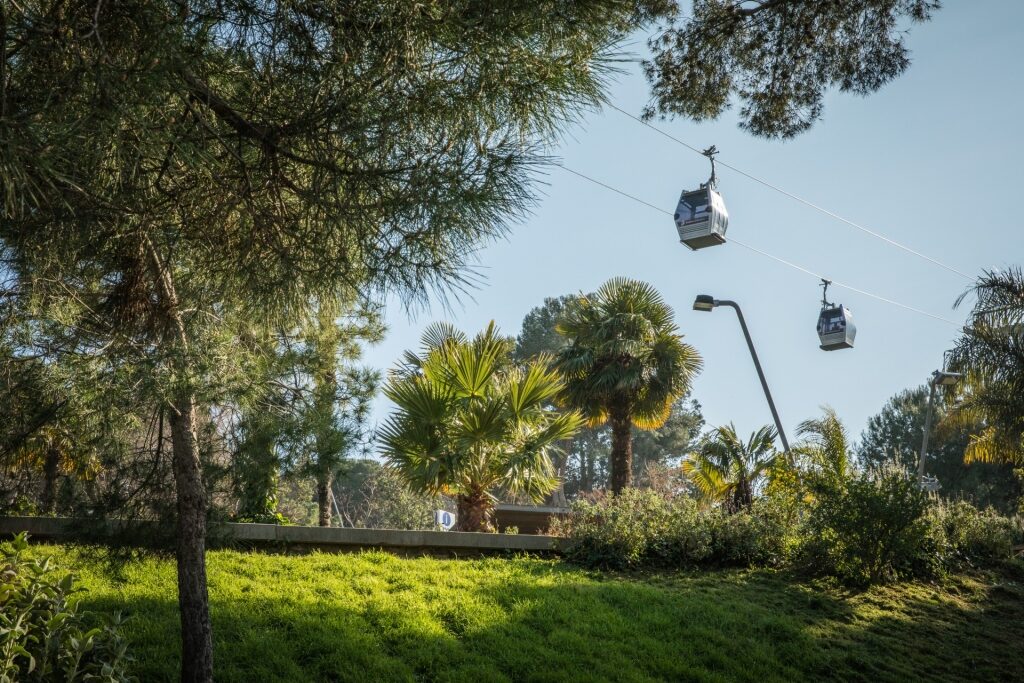
Parc de Montjuïc
Parc de Montjuïc is one of the best parks in Barcelona, situated in a lofty position atop Montjuïc Hill. This is the lungs of the city, home to hundreds of plants and trees, including indigenous parasol pines and carob trees. Some of Barcelona’s best cultural institutions and landmarks are found here, too.
There’s the honeycomb-hued former military fortress, Montjüic Castle; the 1992 Olympic stadium; and Poble Espanyol Spanish village, all waiting to be visited after exploring Parc de Montjuïc’s tree-lined trails.
To reach Parc de Montjuïc, take the funicular railway from Paral·lel station in Ciutat Vella to the Parc Montjuïc stop. From there, you can also ride the cable car to Castell de Montjuïc for more bird’s-eye views of this beautiful Spanish city.
Parc de la Ciutadella
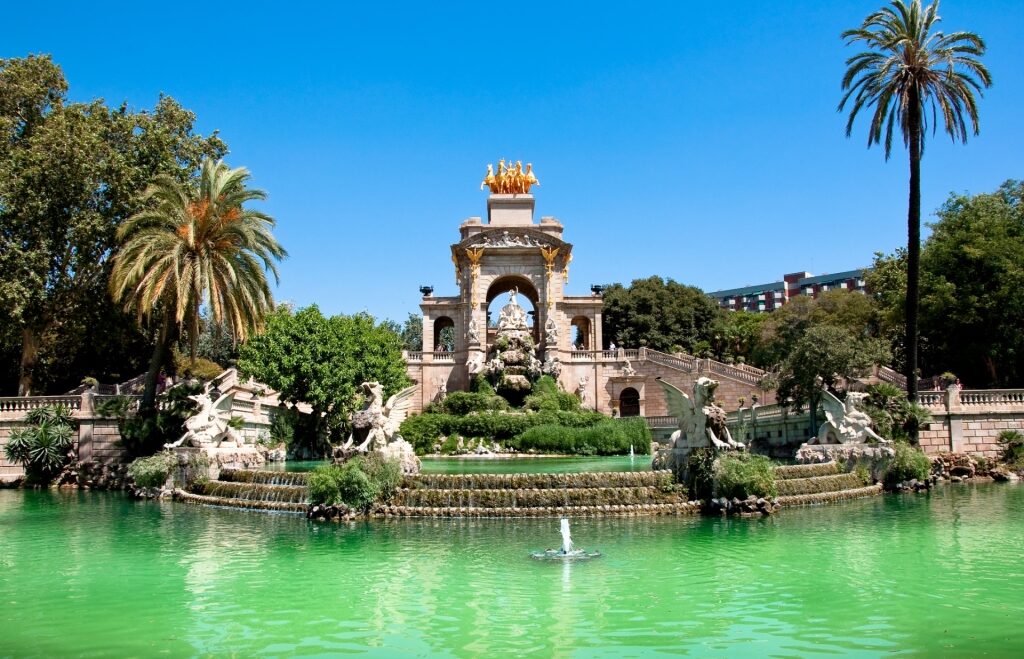
Parc de la Ciutadella
Situated in the city center, the 77-acre Parc de la Ciutadella is one of the most beautiful parks in Barcelona and a true oasis, with sun-dappled gardens, tall palm trees, and secluded picnic areas.
You could easily spend a full day at Parc de la Ciutadella, since it’s also home to the Parliament of Catalonia and the Zoological Museum at Barcelona Zoo.
One of Parc de la Ciutadella’s biggest draws is the small boating lake, a romantic spot to enjoy a date or take the kids.
The park is filled with eye-catching statues and monuments, including the flamboyant Josep Fontserè-designed Cascada Monumental at the north entrance. This show-stopping monument is loosely based on Rome’s Trevi Fountain, featuring a tiered waterfall in front of stone-carved dragons and figures of Roman mythology.
The whole thing is topped by a gold-painted sculpture of Quadriga de l’Aurora, the Roman goddess Aurora, who is riding a chariot drawn by four horses. On a sunny Barcelona day, the statue shimmers beautifully in the emerald–hued pond below.
Jardins de Joan Brossa
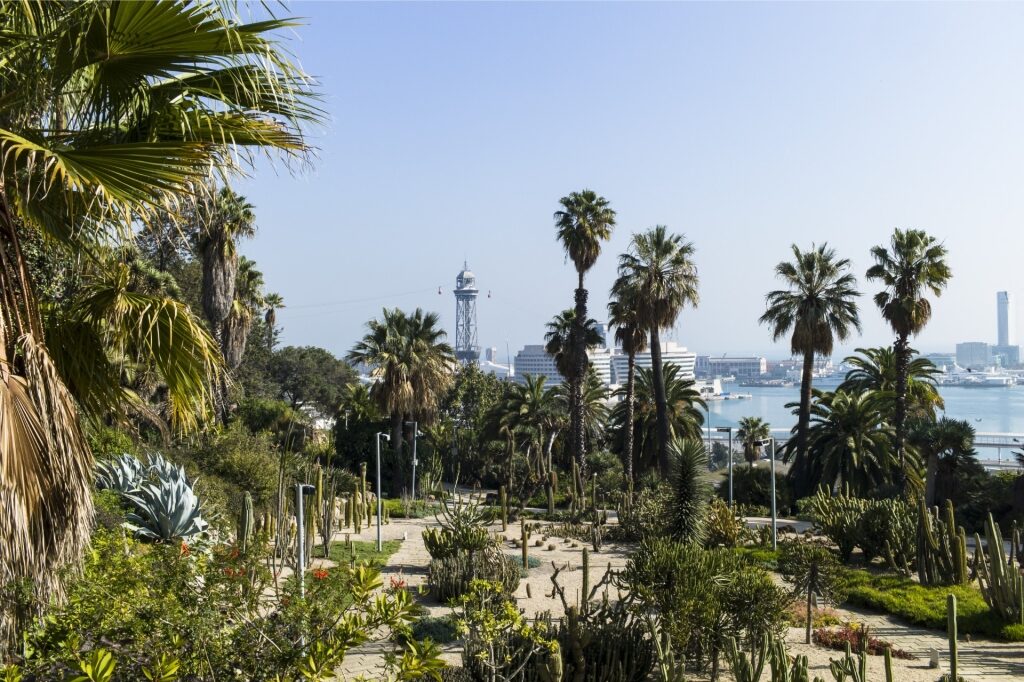
Jardins de Joan Brossa
The haven-like Jardins de Joan Brossa is named in honor of the 20th century Catalan playwright, poet, and artist, and a prominent figure in Catalan literature, Joan Brossa.
Jardins de Joan Brossan lies within Montjüic, on the site of the former Montjuïc Amusement Park. This luxuriant green zone is now one of the best parks in Barcelona, filled with rich vegetation, including a variety of cedar, pine, and cypress trees.
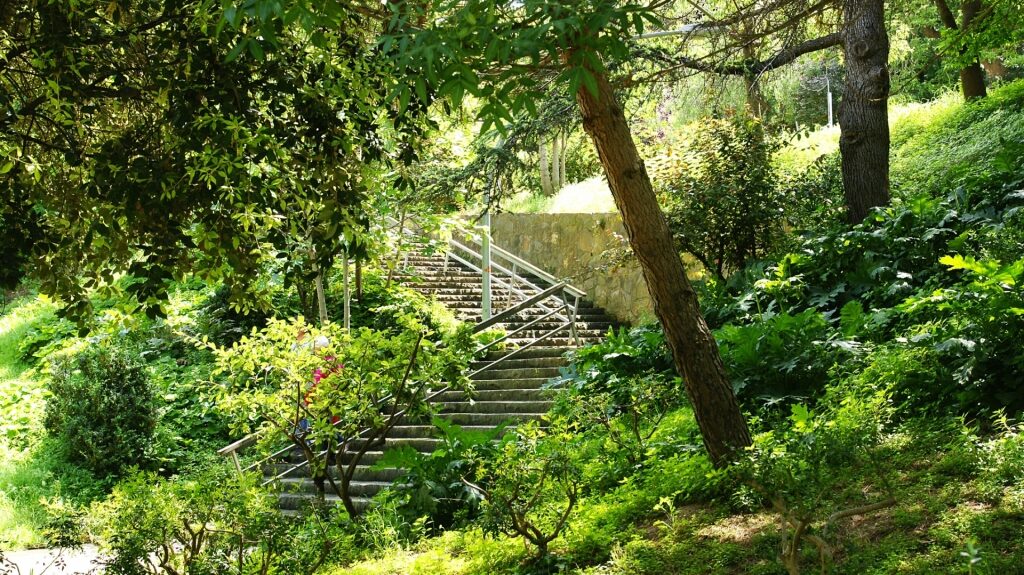
Jardins de Joan Brossa
There are Mediterranean olive trees, holm oaks, and French tamarisk, along with an array of blossoms, including coojongs, pagoda trees, magnolias, and acacias. Jardins de Joan Brossa’s selection of palm trees add an exotic feel, with fan, Mediterranean dwarf, and chusan varieties.
Look out for poetry and sculptural artwork in the park. There is a plaque by the main entrance on Plaça de Dante, citing Brossa’s poem “Música d’arpa.” Sculptures include remnants of the gardens’ life as an amusement park, including “Josep Cañas’ Carmen Amaya,” a tribute to a Barcelona-born flamenco dancer, and “Núria Tortras’s Charlot,” depicting Charlie Chaplin climbing on top of a globe.
After strolling the park’s tranquil paths, head to Salts, a restaurant and bar just above Jardins de Joan Brossa on Avenue Miramar. A tasty menu of snacks, tapas, salads, and sandwiches is available on the outdoor terrace, with tempting cocktails and views of Barcelona.
Jardins del Palau de Pedralbes
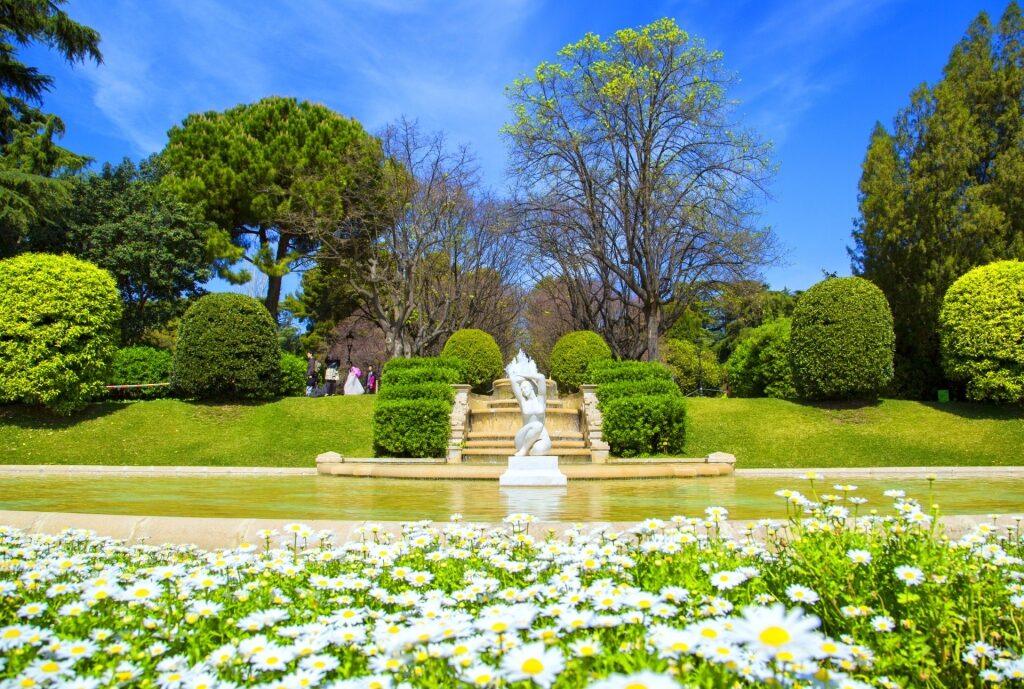
Jardins del Palau de Pedralbes
Jardins del Palau de Pedralbes, or the Royal Palace of Pedralbes, lies near Spotify Camp Nou, Barcelona Football Club’s show-stopping soccer stadium on Av. Diagonal in the Les Corts district.
Jardins del Palau de Pedralbes is one of the most romantic gardens in Barcelona, incorporating both French and English styles within its walled, bougainvillea-festooned perimeter.
Pass through the Jardins del Palau de Pedralbes’ wrought-iron gates and admire the pastel-hued former royal palace and the oval pool in front of it.
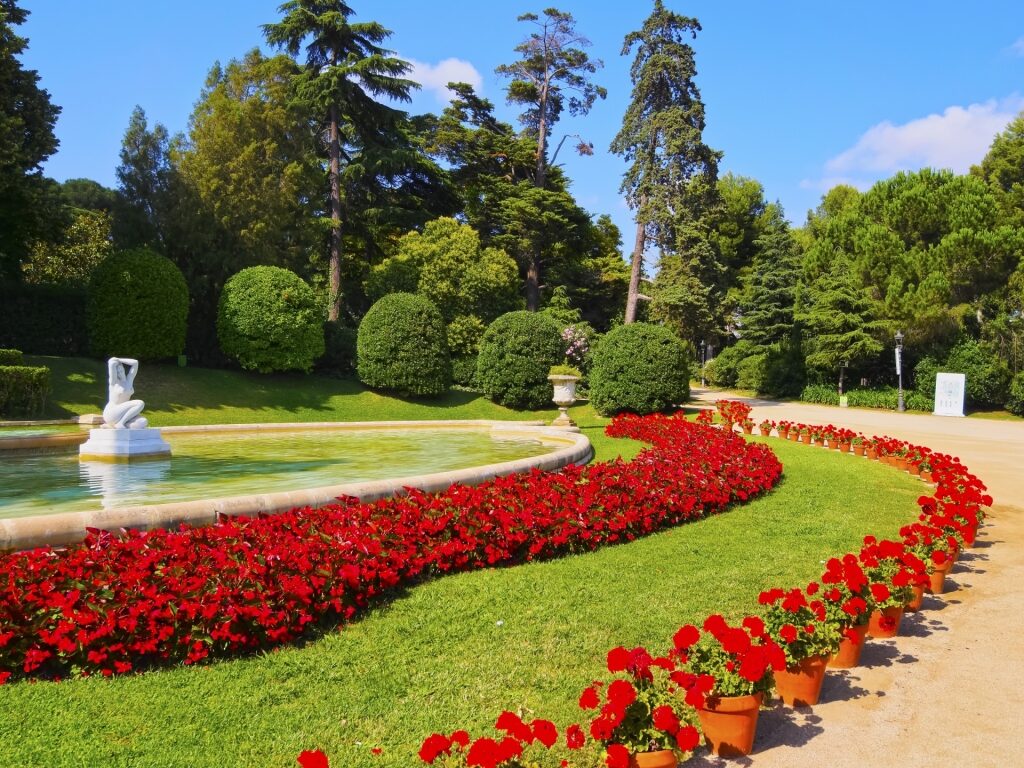
Jardins del Palau de Pedralbes
Palau de Pedralbes was gifted to the Spanish royal family by then mayor, Joan Antoni Güell, in 1926. When the Spanish Republic was established in 1931, the palace and its sumptuous gardens—some of which were designed by Gaudí—were given to the city and the premises took on another guise as the Museu d’Arts Decoratives.
Despite the Barcelona museum moving locations several times, the gardens remain a highlight and joyous space for visitors to enjoy. The lush garden features orange and lime trees, Himalayan, Japanese, and Atlas cedars, cypresses, pines, and palms.
Font d’Hèrcules, a wrought-iron and stone fountain designed by Antoni Gaudí, is located by the serene bamboo woods. This secluded spot lay hidden for decades, only rediscovered during a clean up of the gardens in 1984—a century after it was designed.
Jardins de Laribal
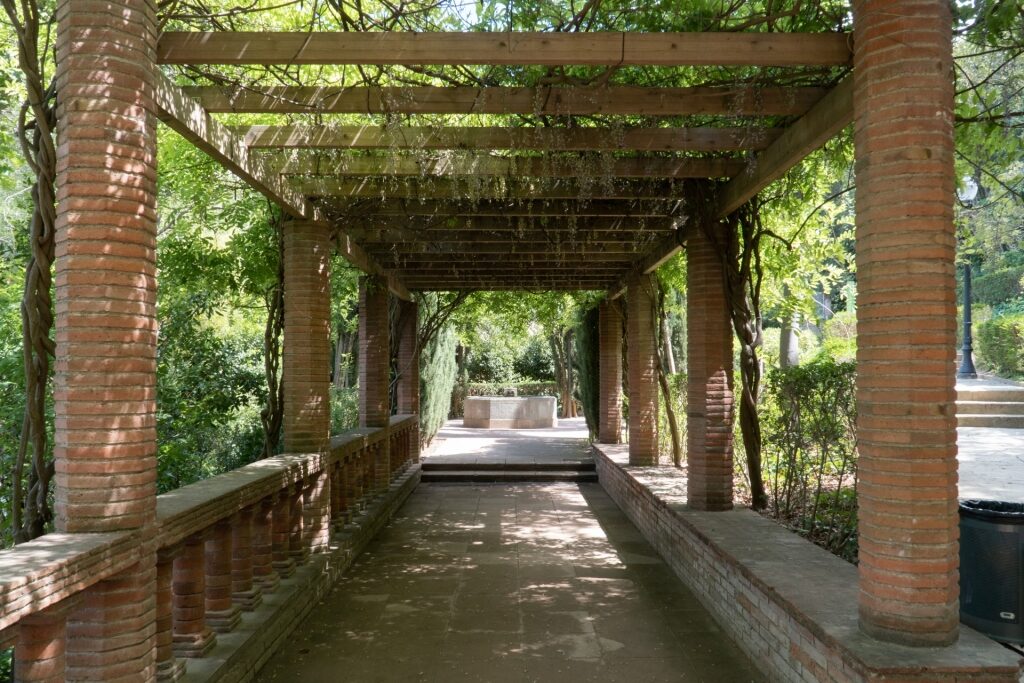
Jardins de Laribal
Of all the parks in Barcelona, Jardins de Laribal is one of the most photogenic. Completed in 1922, Jardins de Lariba is located on Montjüic hill and is one of the closest Barcelona gardens to the Catalan Museum of Archaeology and Fundació Joan Miró.
The upper part of Jardins de Laribal belonged to the estate of the late 19th-century lawyer and journalist Josep Laribal. Today, this spectacular setting is home to a fragrant rose garden, pretty tiled benches, and some of the best views of Barcelona.
There’s creeping ivy, a wisteria pergola that blooms with shades of violet and lavender in spring, and a variety of roses that flourish in summer. Soak in the sound of the ornamental streams and the heavenly aroma of Seville oranges, cypresses, eucalyptuses, and lavender as you roam this delightful garden.
Jardins de Mossèn Costa i Llobera
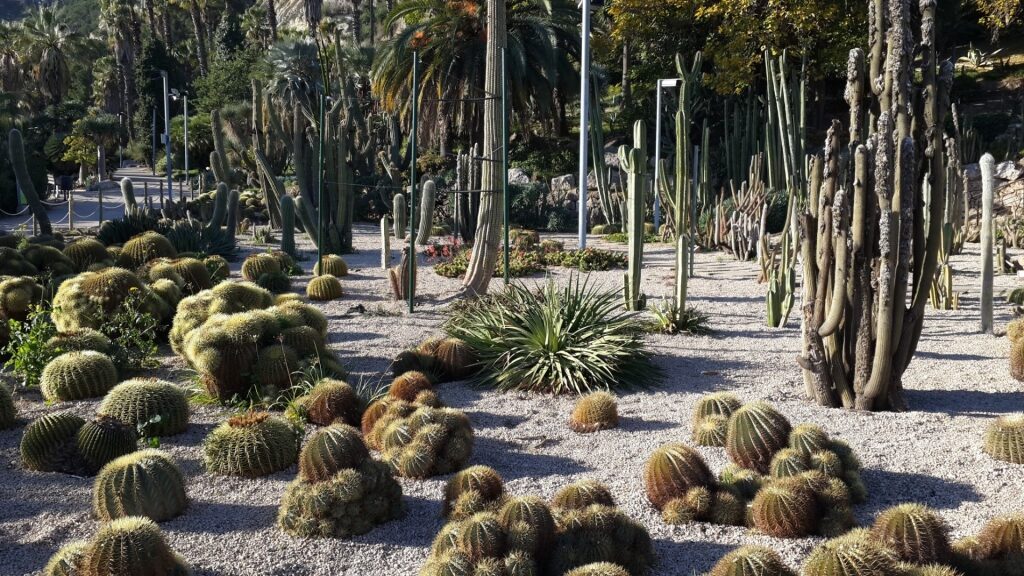
Jardins de Mossèn Costa i Llobera
You’ll find Barcelona’s exquisite Jardins de Mossèn Costa i Llobera near the city’s port, beneath Montjüic hill. If you’re a fan of prickly succulents, this is the best Barcelona garden for you.
Jardins de Mossèn Costa i Llobera was officially opened in 1970 following a joint project between the architect Joaquim Maria Casamor and the gardening teacher and expert in succulent plants, Joan Pañella.
Nearly eight acres of plants include native Spanish species and varieties from the wider Mediterranean, as well as species from high mountains, subdesert, desert, and tropical regions.
Look out for short-leaved aloe from South Africa, African stone plants, and barrel cacti from Mexico, as well as a wide selection of cacti from across South America.
Once you’ve explored this wonderful oasis, take a seat at the sultry Martínez restaurant next to the park for gourmet Spanish dishes of Costa Brava red shrimps, fragrant paella, and fresh beetroot salad.
Parc del Laberint d’Horta
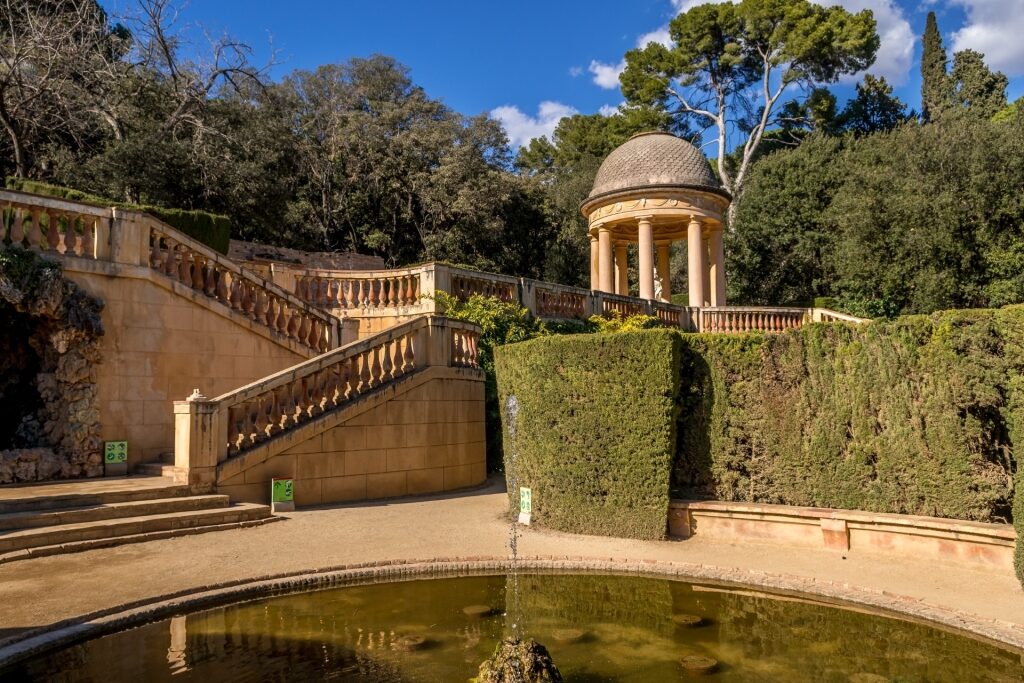
Parc del Laberint d’Horta
This historic, manicured garden lies within woodlands in the Horta-Guinardó district, on the precipice of Barcelona and the Collserola mountain range.
Set within a grand estate, Parc del Laberint d’Horta boasts an 18th-century neoclassical garden and a 19th-century romantic garden. Visitors are invited to get lost in the emerald-green maze, carved from pollarded cypress trees and with a statue of Eros, the Greek god of love, in the center.
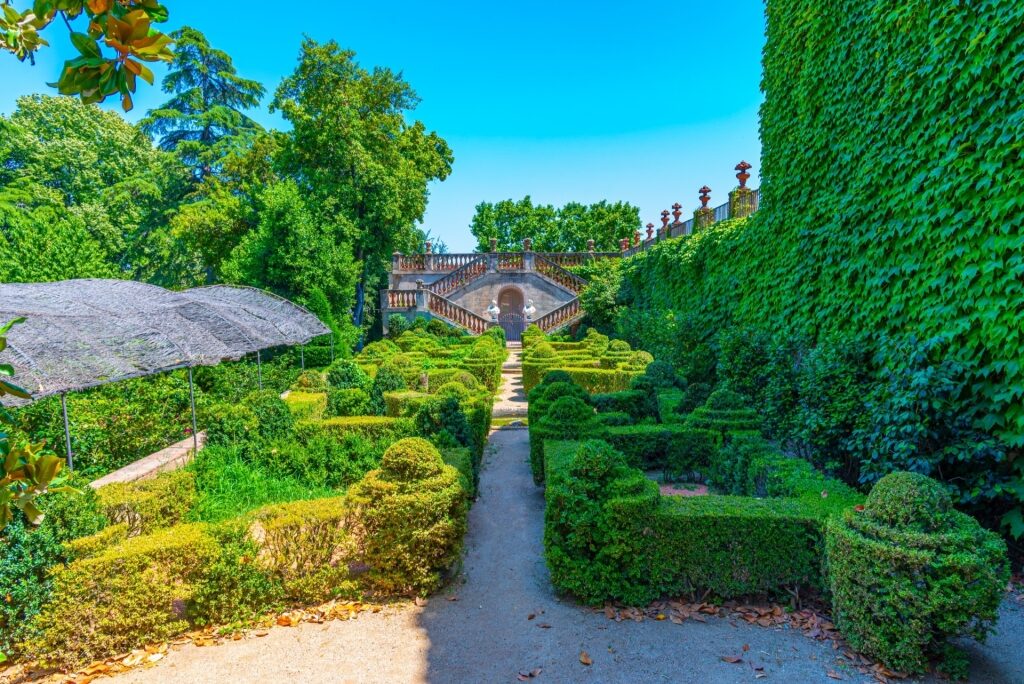
Parc del Laberint d’Horta
Designed in 1792 by Italian engineer Domenico Bagutti for the owner of the estate, Joan Desvalls, the Marquis of Llupià and Alfarràs, Parc del Laberint d’Horta is Barcelona’s oldest garden. The landscape is exquisite, with flower beds, tall trees, and decorative sculptures.
Wander among the glorious camelia plantation and evergreen oaks. There is a linden, jupiter, and sequoia tree, and a pretty canal, waterfalls, water jets, and fountains add to the tranquility.
Pack a picnic and enjoy a Catalan lunch of Iberico ham, cheeses, breads, and olives. There’s a kiosk selling ice cream, soda, water, and snacks, and a children’s playground by the picnic area.
Jardins de la Tamarita
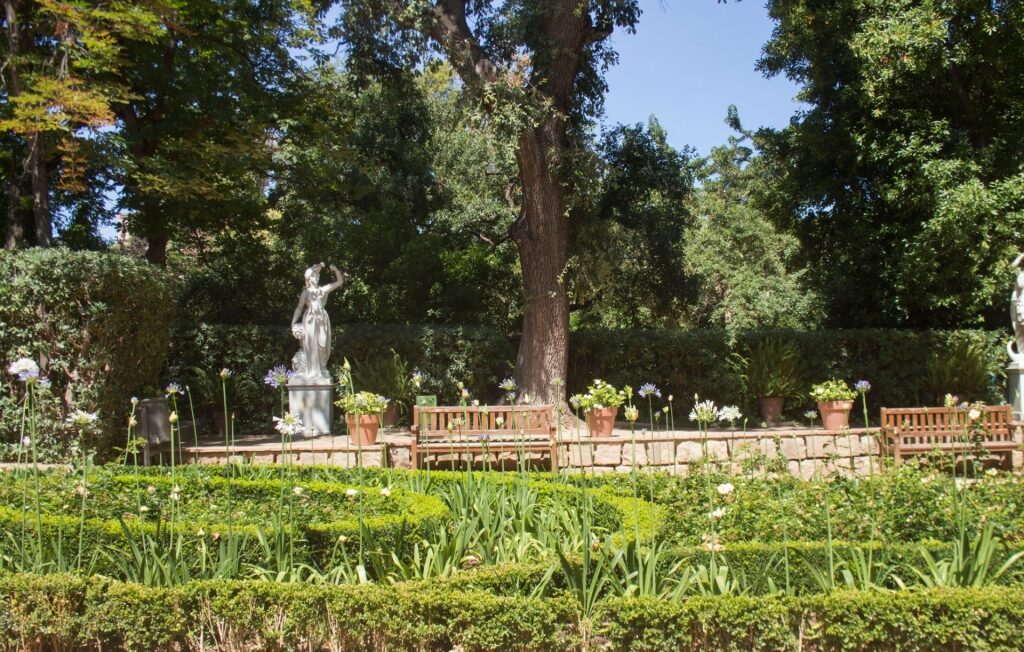
Jardins de la Tamarita
This elegant green square is a former private garden and now a wonderful sanctuary that’s open to the public, located in the northern Sarrià-Sant Gervasi district of Barcelona.
Jardins de La Tamarita retains a lovely, tucked-away feel, surrounded by mansion buildings. If you book ahead, you might be able to get a reservation at Àbac, a decadent fine-dining restaurant across from the park, where tables are among the most sought-after in the city.
Inside the gardens, walk among the foliage, including myrtle, privet, and cheesewood shrubs. There are Seville orange trees, jacaranda, and European yews, plus a stream called Torrent del Frare Blanc, nestled among silver limes, bamboos, and cypresses.
Don’t miss the 75-foot English oak—a rarity in Spain—plus an Australian silk oak, and purple-leaf European beech.
Parc de Cervantes
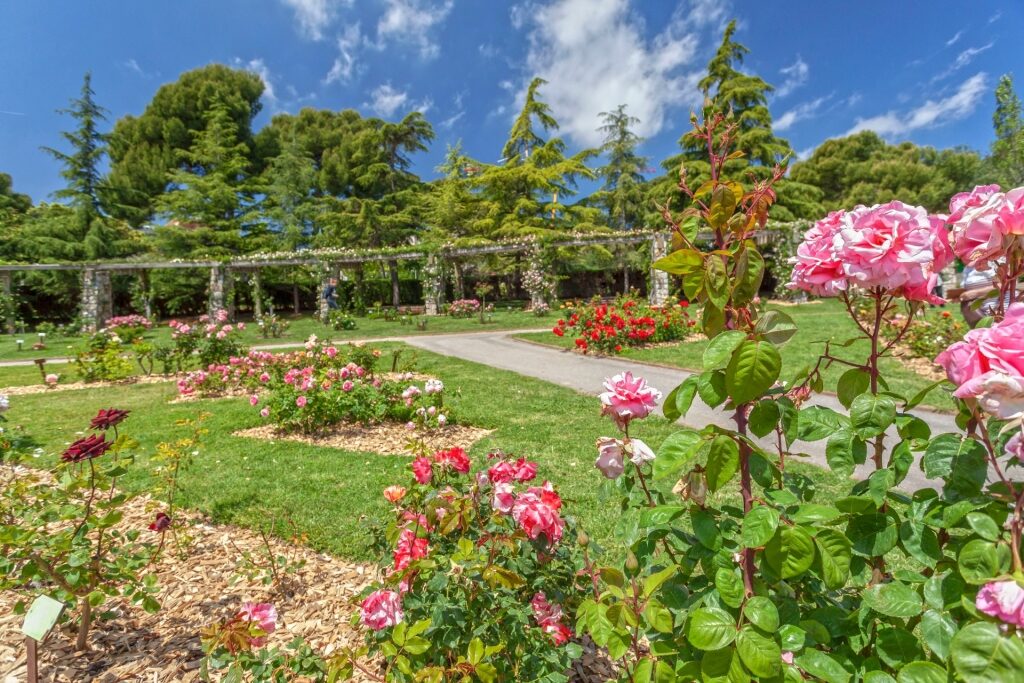
Parc de Cervantes
This 22-acre triangular park in the Pedralbes neighbourhood is home to a scented rose garden, with vibrant yellow, blue, red, and pink miniature and climbing roses on display.
You’ll want to pack your camera for a visit to Parc de Cervantes to capture some of the 10,000 rose bushes—making up around 150,000 rose stems—that bloom between May and July.
Follow the circular route around the rose garden to take in rose bushes from different continents. There are monuments and statues to admire, too, including a stone monolith of writer and diplomat Àngel Ganivet by sculptor Jaume Monràs.
Located at the southwest edge of Avinguda Diagonal, Parc de Cervantes is easy to reach via the city’s green L3 Metro line.
Parc de l’Espanya Industrial
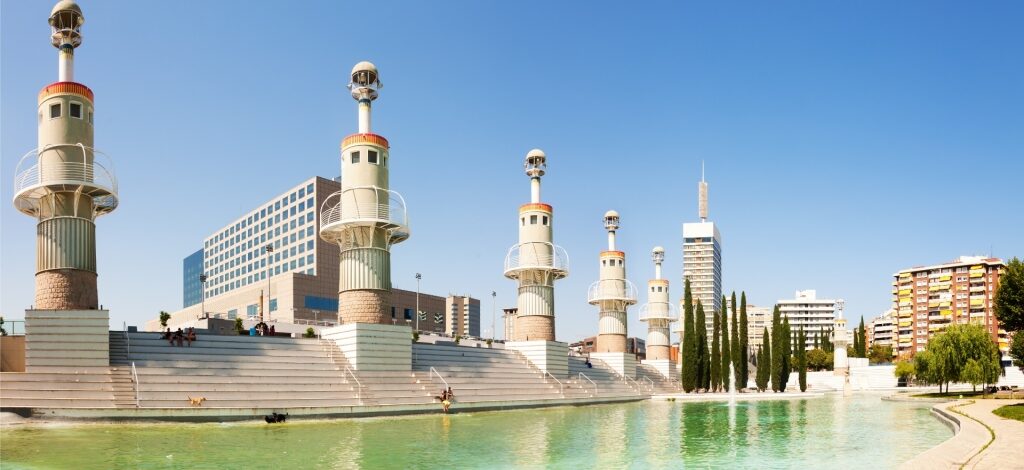
Parc de l’Espanya Industrial
Parc de l’Espanya Industrial is a magnificent park opposite Barcelona-Sants train station on the site of a former textile mill, La España Industrial. When the mill closed, the space was transformed into one of the best urban Barcelona gardens, designed by Basque architect Luis Peña Ganchegui and opened in 1985.
One of the most striking aspects of the park are the nine towers located at the top of the steps leading to the boating lake. Tall cypress trees are scattered around the lake and there are plenty of grassy areas to enjoy a picnic.
The park features a giant dragon sculpture, used as a children’s slide, by artist Andrés Nagel. Sculptures created for the 1929 International Exhibition are on permanent display within the park, too, including “Neptune” by Manuel Fuxà; “Venus” by José Pérez Peresejo; and “Oxen of Plenty” by Antoni Alsina.
Rent a paddle boat or stroll around the lake and you might encounter some of the park’s resident bird life: red-crested pochards, grey herons, and tufted ducks.
Parc Güell
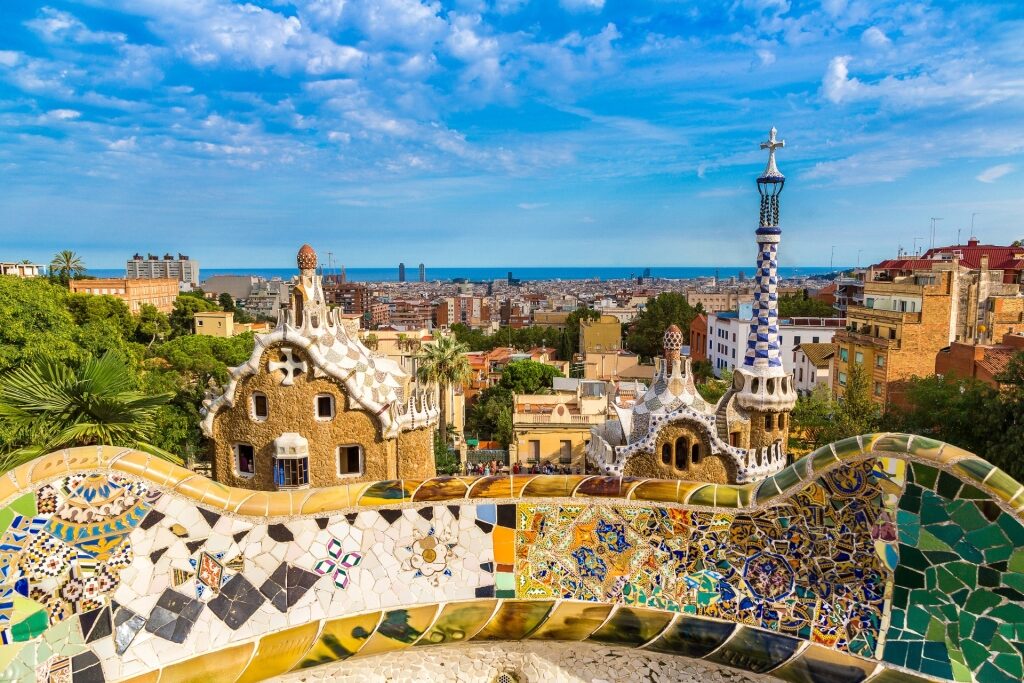
Parc Güell
The UNESCO-worthy Parc Güell is one of the most beautiful gardens in Barcelona, located in the northern fringes of the city, below the Collserola mountains.
This 30-acre park was designed by famous Catalan architect Antoni Gaudí, with help from his assistant, Francesc Berenguer. Originally, Parc Güell was designed as an upmarket residential estate, but when no buyers came forward to purchase the initial two buildings, the estate was turned into a fanciful park.
Parc Güell’s buildings are straight out of a storybook, including the gate house, Casa del Guarda, and the peach-colored Gaudí House Museum, which became Gaudí’s home from 1906 until his death in 1926.
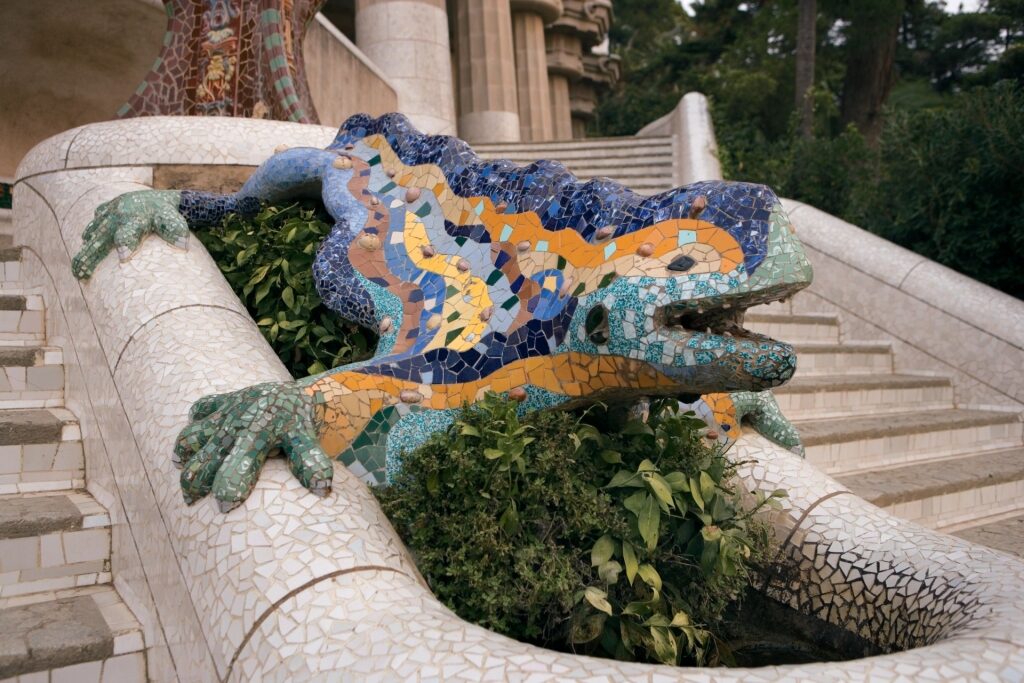
Parc Güell
Gaudí further put his imaginative stamp on the park, which features a grand mosaic-clad staircase with colorful mosaic lizards. The eye-popping Sala Hipòstila features 86 doric columns, and a central plaza area with fabulous city views.
Join a one-hour guided tour to learn more about the park’s history and architecture before following the trails around the Aleppo pine woodlands. There are olive, oak, and carob trees, along with magnolias, wisteria, rosemary and lavender.
Read: Three Days in Barcelona
Parc del Guinardó
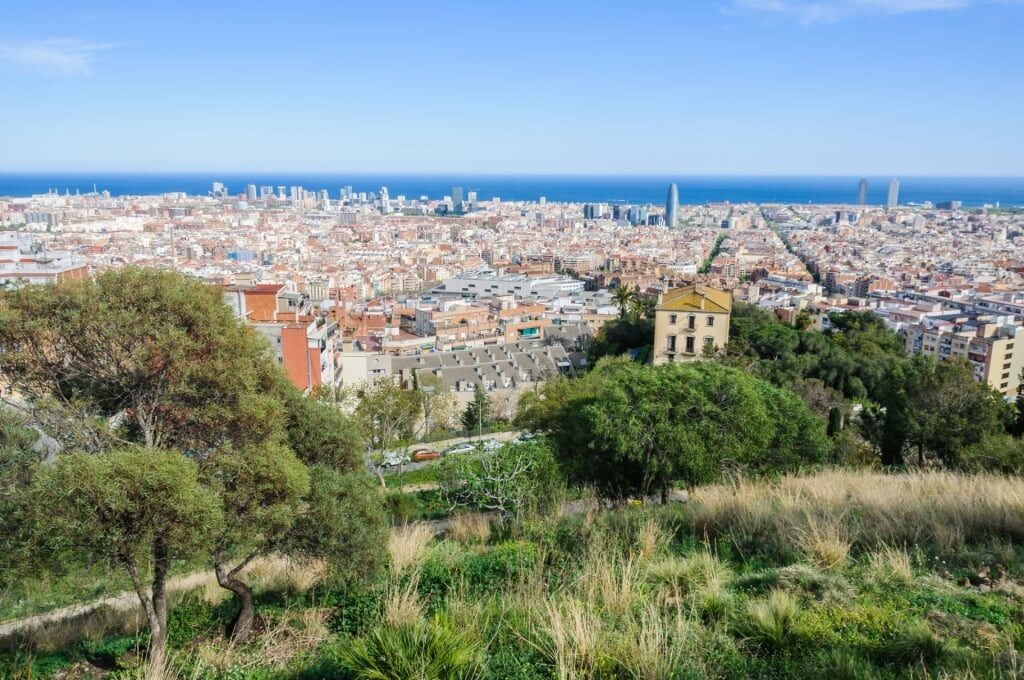
Parc del Guinardó
Barcelona gardens include the unspoilt Parc del Guinardó in the Horta-Guinardó neighborhood, home to a lush forest of pines and flowering rosewood trees, plus fountains, waterfalls, and a children’s play area.
Parc del Guinardó is one of the best parks in Barcelona for its rustic, faraway feel and is the place to go for a crowd-free hike and for sublime city views from the park’s many miradors.
This lesser-known spot was designed in 1918 by French landscaper Jean-Claude Nicolas Forestier, who was also responsible for the Champs de Mars below the Eiffel Tower in Paris.
To reach Parc del Guinardó, take the number 22 bus from Plaça de Catalunya and get off at the final stop, Carrer de la Gran Vista-Plaça de la Mitja Lluna, to wander through the park. The leisurely bus journey takes around 50 minutes and passes landmarks such as Gaudí’s Casa Milà and Casa Batlló.
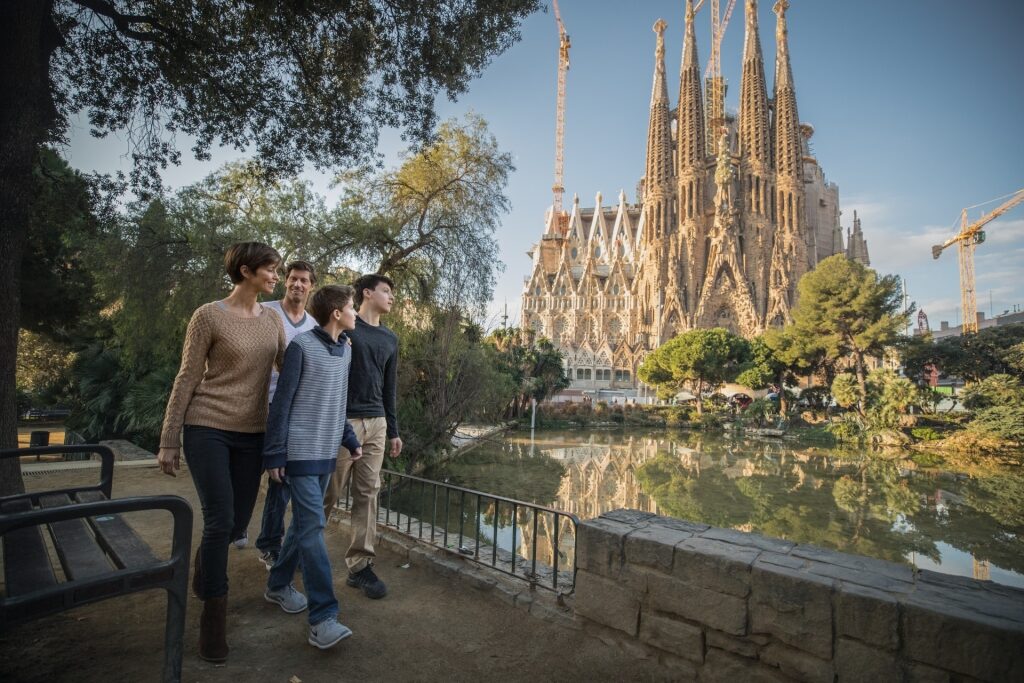
Sagrada Familia
Discover some of these leafy havens for yourself on your next visit to Barcelona. Browse Celebrity’s cruises to Barcelona and plan your next unforgettable getaway.
